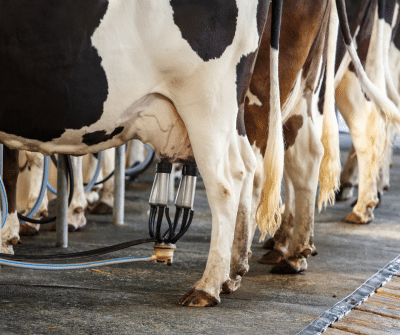 The USDA announced that the October Federal Order Class III price rose to $21.61 per hundredweight. That was $5.18 more for the month, and $2.89 above October 2019.
The USDA announced that the October Federal Order Class III price rose to $21.61 per hundredweight. That was $5.18 more for the month, and $2.89 above October 2019.
So far, the Class III price has averaged $17.89 for the year–with $12.14 being the lowest monthly price during May and $24.64 in July.
The Class IV component price was 72-cents higher than last month at $13.47, but $2.92 less than last year.
Price drivers
Factors contributing to higher cheese prices include cheese production, retail sales, government purchases and exports.
The latest dairy product production report was for August showing American cheese production 1.3% lower than a year ago with total cheese production 2.1% lower. As consumers continue to eat more meals at home retail cheese sales have been relatively strong. The government is purchasing cheese under the third round of the Farm to Families Food Box program which ends on October 31st.
With cheese prices above world prices it was surprising that August cheese exports were 17% higher than a year ago. Dry whey exports were 54% high than a year ago with almost all the increase contributed to China as they attempt to build back their swine herd.
Butter prices have been rather weak all year. A year ago at this time butter was over $2 per pound. Butter has been below $2 per pound all year being as low as $1.15 in April and only as high as $1.90 in June. It is now $1.4975.
But nonfat dry milk prices have improved with very strong exports. August exports were 35% higher than a year ago. Nonfat dry milk was $1.03 per pound early September and is now $1.1275. This will push the Class IV price from $12.75 in September to about $13.55 in October but still leaving more than a $7 spread between Class III and Class IV prices.
Milk production impact
Milk production continues to run at a relatively high level putting downward pressure on milk prices. USDA’s report on September milk production showed milk production 2.3% higher than a year ago, the result of 0.4% more cows and 2.0% increase in milk production per cow.
Milk cow numbers have been increasing since July, with July up 7,000 head, August 4,000 and September 5,000. Of the 24 reporting states 16 had more milk. All the five leading dairy states that produce over half of the nation’s milk production had higher milk production.
Compared to last year production was up 3.2% in California, 0.7% in Wisconsin, 2.9% in Idaho, 1.4% in New York and 6.5% in Texas. Of all the states South Dakota had the largest increase at 12.3%. Other strong increases were Indiana at 9.0%, Colorado at 7.8%, and Kansas at 6.8%.
There were decreases in milk production of 2.2% in Arizona, 3.7% in Florida, 5.5% in Vermont and 0.9% in New Mexico. USDA is forecasting 2021 milk production to be 1.4% higher than this year with just a 5,000 head increase in the average herd size and a 1.4% increase in milk per cow.
At this level of milk production, it will take good domestic sales and exports to provide good milk prices.
Less volatile price outlook?
As of now it seems reasonable to assume 2021 milk prices could be less volatile. Class III could be in the $16’s first half of the year, reach the $17’s in the second a half and averaging in the high $16’s or low $17’s for the year.
If the COVID-19 is under control, there could be a good rally in milk prices for the second half of the year. But, this is far from certain. Dairy farmers should seriously consider signing up for the Dairy Margin Coverage program for 2021.
Source: Wisconsin State Farmer/Wisconsin Ag Connection




